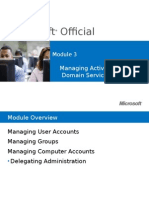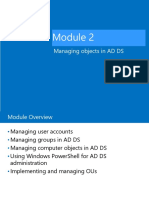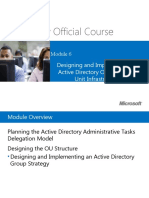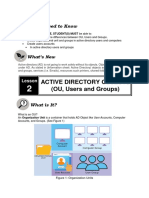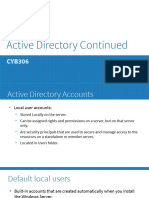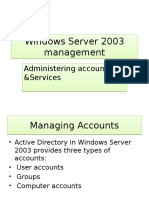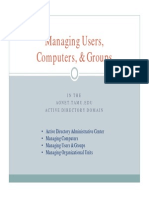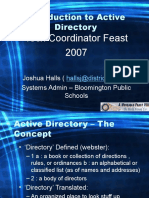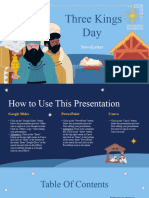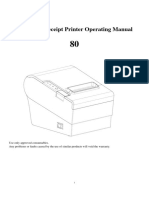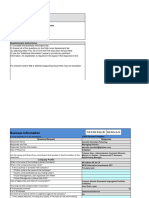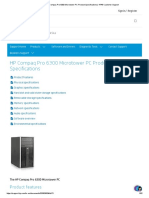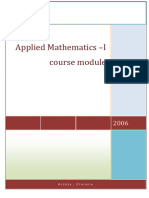Managing objects in AD DS
Module Overview
• Managing user accounts
• Managing groups in AD DS
• Implementing and managing OUs
1
�Managing user accounts
• Creating user accounts
• Configuring user account attributes
• Demonstration: Managing user accounts
• Managing inactive and disabled user accounts
Creating user accounts
• Users accounts:
• Allow or deny access to sign into computers
• Grant access to processes and services
• Manage access to network resources
• User accounts can be created by using:
• Active Directory Users and Computers
• Active Directory Administrative Center
• Considerations for naming users include:
• Naming formats
• UPN suffixes
2
�Configuring user account attributes
User properties include the following categories:
• Account
• Organization
• Member of
• Password Settings
• Profile
• Policy
• Extensions
Demonstration: Managing user accounts
In this demonstration, you will see how to use
Active Directory Administrative Center to:
• Create a new user account
• Delete a user account
• Move a user account
• Configure user attributes:
• Change department
• Change group membership
3
�Managing inactive and disabled user accounts
• Users accounts that will be inactive for a period
of time should be disabled rather than deleted
• To disable an account in Active Directory Users
and Computers, right-click the account and click
Disable Account from the menu
Managing groups in AD DS
• Group types
• Group scopes
• Implementing group management
• Managing group membership by using Group
Policy
• Default groups
• Special identities
• Demonstration: Managing groups in Windows
Server
4
�Group types
• Distribution groups
• Used only with email applications
• Not security enabled (no SID)
• Cannot be given permissions
• Security groups
• Security principal with a SID
• Can be given permissions
• Can also be email-enabled
You can convert security groups to distribution groups
and distribution groups to security groups
Group scopes
• Local groups can contain users, computers, global groups,
domain-local groups and universal groups from the same
domain, domains in the same forest and other trusted domain
and can be given permissions to resources on the local
computer only
• Domain-local groups have the same membership possibilities
but can be given permission to resources anywhere in the
domain
• Universal groups can contain users, computers, global groups
and other universal groups from the same domain or domains
in the same forest and can be given permissions to any
resource in the forest
• Global groups can only contain users, computers and other
global groups from the same domain and can be given
permission to resources in the domain or any trusted domain
5
� Implementing group management
This best practice for nesting
groups is known as IGDLA
Sales
(global group) Auditors
I: Identities, users, or computers, (global group)
which are members of
ACL_Sales_Read
G: Global groups, which collect (domain-local group)
members based on members’
roles, which are members of
DL: Domain-local groups, which
provide management such as
resource access which are
A: Assigned access to a resource
Implementing group management
I: Identities, users, or
computers,
which are members
of
6
� Implementing group management
I: Identities, users, or
computers, which are
members of
G: Global groups, which Sales
(global group)
collect members based on
members’ roles, which are
members of
Auditors
(global group)
Implementing group management
I: Identities, users, or
computers, which are Sales
members of (global group) Auditors
(global group)
G: Global groups, which
collect members based on ACL_Sales_Read
members’ roles, which are (domain-local group)
members of
DL: Domain-local groups,
which provide management
such as resource access which
are
7
� Implementing group management
I: Identities, users, or
computers, which are
members of Sales
Auditors
G: Global groups, which (global group)
(global group)
collect members based on
members’ roles, which are ACL_Sales_Read
members of (domain-local group)
DL: Domain-local groups,
which provide management
such as resource access
which are
A: Assigned access to a
resource
Implementing group management
This best practice for nesting
groups is known as IGDLA
I: Identities, users, or Sales
computers, which are (global group) Auditors
members of (global group)
G: Global groups, which ACL_Sales_Read
collect members based on (domain-local group)
members’ roles, which are
members of
DL: Domain-local groups,
which provide management
such as resource access
which are
A: Assigned access to a
resource
8
�Managing group membership by using Group Policy
• Restricted Groups can simplify group
management
• You use it to manage local and AD DS groups
Managing group membership by using Group Policy
Members can be added to the group and the
group can be nested into other groups
9
�Default groups
Carefully manage the default groups that provide administrative
privileges, because these groups:
• Typically have broader privileges than are necessary for
most delegated environments
• Often apply protection to their members
Group Location
Enterprise Admins Users container of the forest root domain
Schema Admins Users container of the forest root domain
Administrators Built-in container of each domain
Domain Admins Users container of each domain
Server Operators Built-in container of each domain
Account Operators Built-in container of each domain
Backup Operators Built-in container of each domain
Print Operators Built-in container of each domain
Cert Publishers Users container of each domain
Special identities
• Special identities:
• Are groups for which the operating system controls
membership
• Can be used by the Windows Server operating system
to provide access to resources based on the type of
authentication or connection, not on the user account
• Important special identities include:
• Anonymous Logon • Interactive
• Authenticated Users • Network
• Everyone • Creator Owner
10
�Demonstration: Managing groups in Windows Server
In this demonstration, you will see how to:
• Create a new group and add members to the group
• Add users to the group
• Change the group type and scope
• Configure a manager for the group
Implementing and managing OUs
• Planning OUs
• OU hierarchy considerations
• Considerations for using OUs
• AD DS permissions
• Delegating AD DS permissions
• Demonstration: Delegating administrative
permissions on an OU
11
�Planning OUs
Location-based strategy • Static
• Delegation can be complicated
Organization-based strategy • Not static
• Easy to categorize
Resource-based strategy • Not static
• Easy to delegate administration
Multitenancy-based strategy • Static
• Easy to delegate administration
• Easy to include and separate new
tenants
Hybrid strategy
OU hierarchy considerations
Align OU strategy to administrative requirements, not the
organizational chart, because organizational charts are
more subject to change than your IT administration model
AD DS inheritance behavior can simplify Group Policy
administration because it allows group polices to be set on
an OU and flow down to lower OUs in the hierarchy
Plan to accommodate changes in the IT administration
model
12
�Considerations for using OUs
• OUs can be created using AD DS graphical tools
or command-line tools
• New OUs are protected from accidental deletion
by default
• When objects are moved between OUs:
• Directly assigned permissions remain in place
• Inherited permissions will change
• Appropriate permissions are required to move
objects between OUs
AD DS permissions
• Users receive their token (list of SIDs) during
sign in
• Objects have a security descriptor that describes:
• Who (SID) has been granted or denied access
• Which permissions (Read, Write, Create or Delete child)
• What kind of objects
• Which sublevels
• When users browse the Active Directory
structure, their token is compared to the security
descriptor to evaluate their access rights
13
�Delegating AD DS permissions
• Permissions on AD DS objects can be granted to
users or groups
• Permission models are usually object-based or
role-based
• The Delegation of Control Wizard can simplify
assigning common administrative tasks
• The OU advanced security properties allow you
to grant granular permissions
Module Review and Takeaways
• Real-world Issues and Scenarios
• Tools
• Best Practice
• Common Issues and Troubleshooting Tips
14

